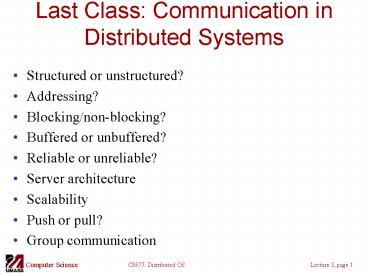Last Class: Communication in Distributed Systems - PowerPoint PPT Presentation
Title:
Last Class: Communication in Distributed Systems
Description:
Last Class: Communication in Distributed Systems Structured or unstructured? Addressing? Blocking/non-blocking? Buffered or unbuffered? Reliable or unreliable? – PowerPoint PPT presentation
Number of Views:60
Avg rating:3.0/5.0
Title: Last Class: Communication in Distributed Systems
1
Last Class Communication in Distributed Systems
- Structured or unstructured?
- Addressing?
- Blocking/non-blocking?
- Buffered or unbuffered?
- Reliable or unreliable?
- Server architecture
- Scalability
- Push or pull?
- Group communication
2
Today Remote Procedure Calls
- Goal Make distributed computing look like
centralized computing - Allow remote services to be called as procedures
- Transparency with regard to location,
implementation, language - Issues
- How to pass parameters
- Bindings
- Semantics in face of errors
- Two classes integrated into prog, language and
separate
3
Conventional Procedure Call
- Parameter passing in a local procedure call the
stack before the call to read
- b) The stack while the called procedure is active
4
Parameter Passing
- Local procedure parameter passing
- Call-by-value
- Call-by-reference arrays, complex data
structures - Remote procedure calls simulate this through
- Stubs proxies
- Flattening marshalling
- Related issue global variables are not allowed
in RPCs
5
Client and Server Stubs
- Principle of RPC between a client and server
program.
6
Stubs
- Client makes procedure call (just like a local
procedure call) to the client stub - Server is written as a standard procedure
- Stubs take care of packaging arguments and
sending messages - Packaging parameters is called marshalling
- Stub compiler generates stub automatically from
specs in an Interface Definition Language (IDL) - Simplifies programmer task
7
Steps of a Remote Procedure Call
- Client procedure calls client stub in normal way
- Client stub builds message, calls local OS
- Client's OS sends message to remote OS
- Remote OS gives message to server stub
- Server stub unpacks parameters, calls server
- Server does work, returns result to the stub
- Server stub packs it in message, calls local OS
- Server's OS sends message to client's OS
- Client's OS gives message to client stub
- Stub unpacks result, returns to client
8
Example of an RPC
2-8
9
Marshalling
- Problem different machines have different data
formats - Intel little endian, SPARC big endian
- Solution use a standard representation
- Example external data representation (XDR)
- Problem how do we pass pointers?
- If it points to a well-defined data structure,
pass a copy and the server stub passes a pointer
to the local copy - What about data structures containing pointers?
- Prohibit
- Chase pointers over network
- Marshalling transform parameters/results into a
byte stream
10
Binding
- Problem how does a client locate a server?
- Use Bindings
- Server
- Export server interface during initialization
- Send name, version no, unique identifier, handle
(address) to binder - Client
- First RPC send message to binder to import
server interface - Binder check to see if server has exported
interface - Return handle and unique identifier to client
11
Binding Comments
- Exporting and importing incurs overheads
- Binder can be a bottleneck
- Use multiple binders
- Binder can do load balancing
12
Failure Semantics
- Client unable to locate server return error
- Lost request messages simple timeout mechanisms
- Lost replies timeout mechanisms
- Make operation idempotent
- Use sequence numbers, mark retransmissions
- Server failures did failure occur before or
after operation? - At least once semantics (SUNRPC)
- At most once
- No guarantee
- Exactly once desirable but difficult to achieve
13
Failure Semantics
- Client failure what happens to the server
computation? - Referred to as an orphan
- Extermination log at client stub and explicitly
kill orphans - Overhead of maintaining disk logs
- Reincarnation Divide time into epochs between
failures and delete computations from old epochs - Gentle reincarnation upon a new epoch broadcast,
try to locate owner first (delete only if no
owner) - Expiration give each RPC a fixed quantum T
explicitly request extensions - Periodic checks with client during long
computations
14
Implementation Issues
- Choice of protocol affects communication costs
- Use existing protocol (UDP) or design from
scratch - Packet size restrictions
- Reliability in case of multiple packet messages
- Flow control
- Copying costs are dominant overheads
- Need at least 2 copies per message
- From client to NIC and from server NIC to server
- As many as 7 copies
- Stack in stub message buffer in stub kernel
NIC medium NIC kernel stub server
- Scatter-gather operations can reduce overheads
15
Case Study SUNRPC
- One of the most widely used RPC systems
- Developed for use with NFS
- Built on top of UDP or TCP
- TCP stream is divided into records
- UDP max packet size lt 8912 bytes
- UDP timeout plus limited number of
retransmissions - TCP return error if connection is terminated by
server - Multiple arguments marshaled into a single
structure - At-least-once semantics if reply received,
at-least-zero semantics if no reply. With UDP
tries at-most-once - Use SUNs eXternal Data Representation (XDR)
- Big endian order for 32 bit integers, handle
arbitrarily large data structures
16
Binder Port Mapper
- Server start-up create port
- Server stub calls svc_register to register prog.
, version with local port mapper - Port mapper stores prog , version , and port
- Client start-up call clnt_create to locate
server port - Upon return, client can call procedures at the
server
17
Rpcgen generating stubs
- Q_xdr.c do XDR conversion
- Detailed example later in this course
18
Summary
- RPCs make distributed computations look like
local computations - Issues
- Parameter passing
- Binding
- Failure handling
- Case Study SUN RPC































